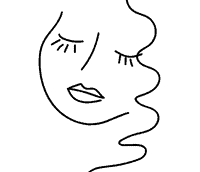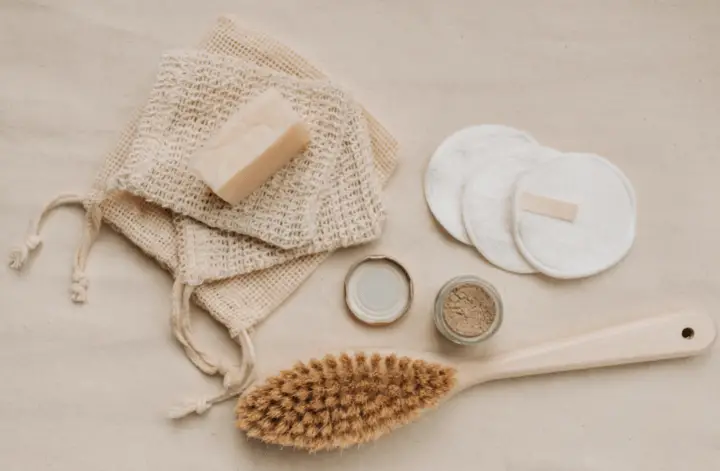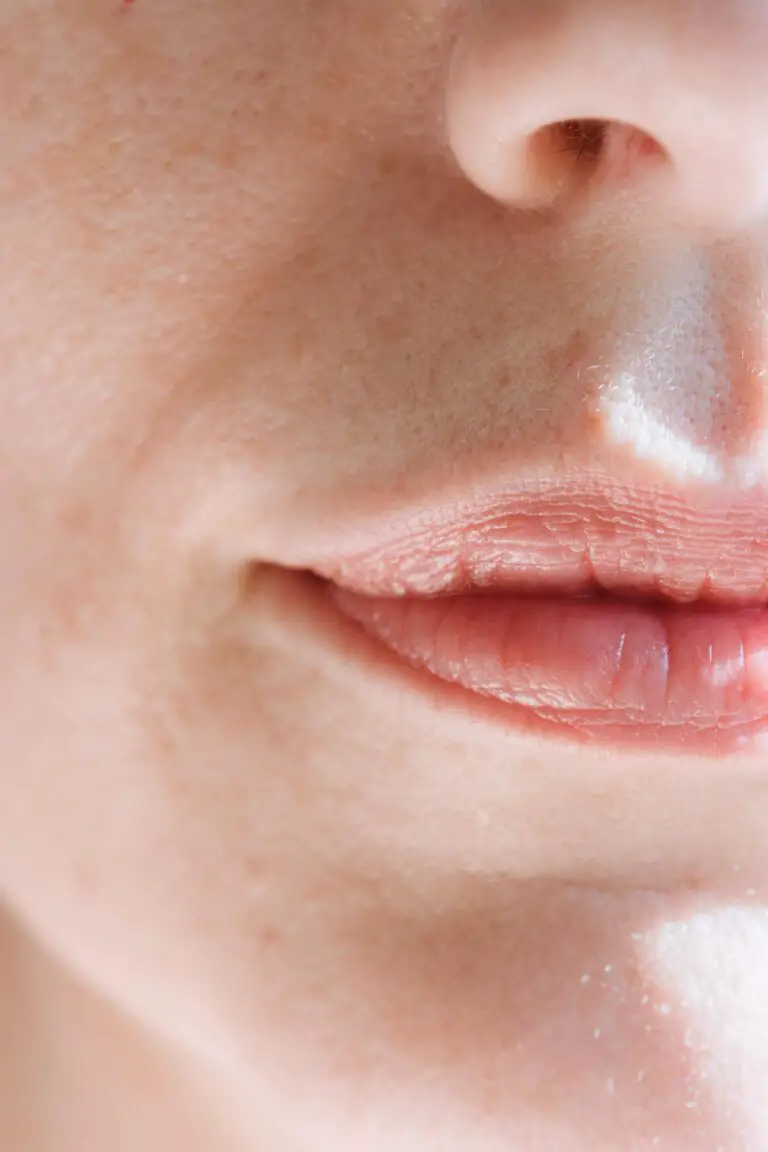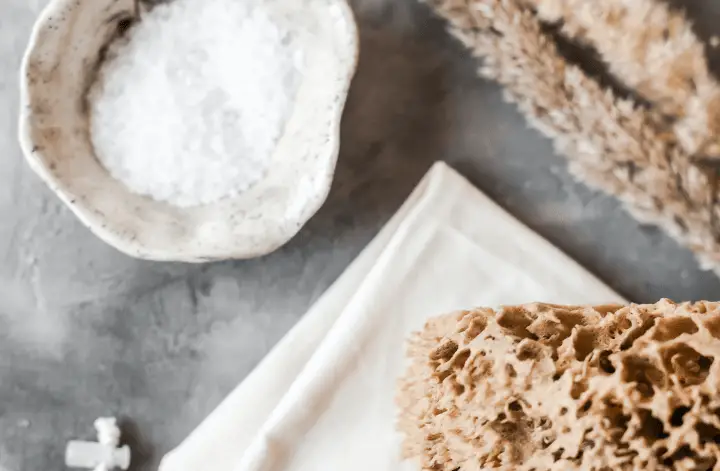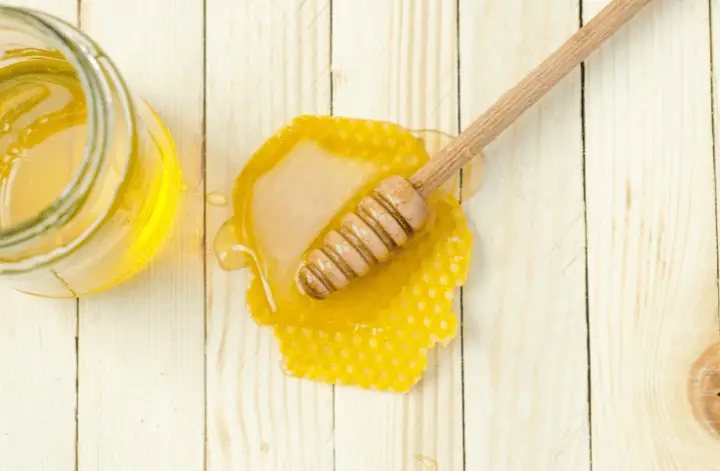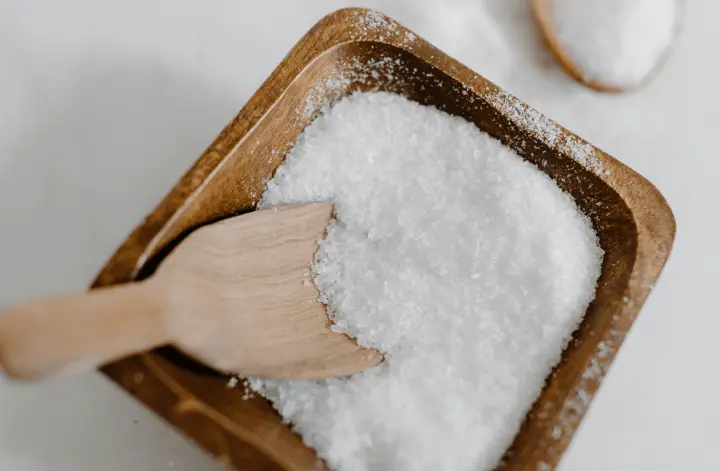This post is all about the simplest and most effective homemade face cleansers you can incorporate into your daily skincare routine.
Cleansing is a crucial part in your skincare. It is also something that is very easy to get wrong. Clean too much, too often, or too abrasively and you’ll damage the skin’s protective barrier, opening it to bacteria and causing it to overreact. It will also dry out your skin because you’re constantly stripping it of oils.
Don’t do it enough, or routinely, and the dead skin cells sitting on the surface will prevent the serums and moisturizers from doing their jobs properly. Your skin will end up looking dull, feeling rough and uneven.
How often should you clean your face
Depending on your lifestyle and skin type you might feel the need to clean your skin twice a day or once a day (or none at all).
Depending on which expert you listen to, they might tell you that it’s absolutely vital to clean your face both in the morning and before bed. Or they might tell you that you can skip the morning, making sure you clean it thoroughly before you go to bed.
One thing they all agree on is if you only clean your face once a day make sure it’s at night, or before bed. This is because it’s important to remove all the impurities and dirt that have accumulated throughout the day, from pollution, dust, sweat, sunscreen, and makeup.
It’s at night, during sleep, that your skin will repair tissues and regenerate – it needs to be able to breathe properly.
Despite what many people believe, homemade face cleansers can be just as effective as the commercial ones. It’s just a question of choosing the right ones for you and your needs.
How to choose the best homemade face cleansers
When choosing a skin cleansing method it’s important to take into account your skin type, skin condition, and your lifestyle.
What kind of day did you have? Were you mostly outdoors or indoors? How much did you sweat? What kind of products did you put on your skin? Makeup? Sunscreen? Do you live in a big city, constantly exposed to pollutants?
Also, you don’t have to use the same homemade face cleansers every single day. Depending on the type of day you had or on the general state of your skin, you might try alternating your cleansing methods.
Out and about all day in a big city, with or without makeup and sunscreen? There’s probably a lot of crap sitting on your skin – get in there with oil-cleansing, or scrub your skin with a cleansing paste.
Been home all day just chilling, or doing work on the computer, or easy chores – it’s a good day for water-only washing, for instance.
Is your skin feeling dry or oily? Are you breaking out? This is a good job for a green clay-based cleanser.
Go through the list of DIY homemade face cleansers in this post and adjust your cleansing methods according to your skin’s needs for that day. Or mix and match to see what works better for you.
Take note of how your skin reacts and make the necessary adjustments.
Best homemade face cleansers according to skin type
Generally speaking, if you have oily and acne-prone skin you can benefit from the more aggressive homemade face cleansers, like the oil and powder-based ones, which will help exfoliate, activate circulation, and smooth out the surface of the skin.
This is good for both helping to heal scar tissue and preventing new one from forming. It will also help to dislodge impurities and oil in clogged pores. For the same reason, it’s good for days when you wear makeup or sunscreen, which can be more trouble to remove thoroughly.
If you have sensitive or inflamed skin you might favor either honey or lactic acid-based cleansers. The honey (raw!) is anti-inflammatory, healing, and gentle on the skin. While milk, yogurt, and cream are known for their skin soothing qualities. Both lactic acid and honey will also very gently exfoliate the top layer of the skin.
For dry and/or mature skin either lactic acid or oil-based homemade face cleansers are best. The lactic acid combines the gentle “acid” exfoliation of the skin with the natural fatty content of the yogurt, cream, or milk (which should be full-fat). The oil-cleansing will of course help nourish the skin, instead of stripping it and making it drier.
Related content: The Best Skincare for Tightening Skin Naturally
HOMEMADE FACE CLEANSERS – Liquid Ingredients
Below is the list of the most effective and readily available (and simple!) homemade face cleansers.
For each one I will explain how they work and how to use them to cleanse your skin. I will also point out for each one what skin type, skin issue, or skin concern they are most useful for.
This will help you decide which one might be most suited to your needs on a more regular basis, or depending on the specific type of day you had.
So, what are the simplest and most effective homemade face cleansers?
1 – Water-only washing
I have two full dedicated posts on the concept of water only washing – one for hair and another for skin. So, check them out if you want to read about it more in-depth. But I first read about water only washing in an interview with dermatologist Dr. Yael Adler, where she states that water is all that’s necessary to clean skin.
Dr. Adler wears makeup, by the way, and she still says water is all you need. She says that the makeup will all transfer to the towel, after rinsing your face.
It might not sound like a serious “homemade” face cleanser, but when a dermatologist announces that you don’t need products on your skin, it definitely warrants some attention!
My personal experience with water-only face washing
Now, I tried water-only skin washing exclusively for maybe over a year, both morning and night. After all that time I can say that it definitely works to an extent.
This means that, while I found it enough to keep the skin clean and healthy, I felt that it wasn’t enough to keep it truly glowing. If I just rinse my face, day and night, and wipe off with a towel I don’t get any breakouts, or rashes, or weird pigmentation, or dryness. But I do feel that my skin lacks vitality sometimes, for lack of a better word.
I assume that was because I was only using one water only face washing method at the time (yes, there’s more than one!) and not properly sloughing off my skin on a regular basis. And the fact that I had an excess of dead skin on the surface no doubt made moisturizers and treatments less effective as well.
So in the end, I made a few adjustments to my routine, incorporating also other cleansing methods and different types of the water only method. Kind of rotating them according to the day and situation, to make sure that I was cleaning my skin properly, but with a minimal disturbance of the protective skin microbiome. This has been working very well for me!
How to do it
So what does basic water-only washing look like? Again, check out my dedicated water only face washing guide for more nuance and methods, but:
Even if you’re not using foaming cleansers, consider that the quality of the water that comes out of the tap is not always the best. If you’re in an area with hard water (like I tend to end up in), the high mineral content of the water will leave residues on the skin’s surface, making it feel dry and uncomfortable.
A water-vinegar toner will also help tighten your pores.
To make a vinegar toner:
- 1 part table vinegar
- 7 or 8 parts water
- Mix together in a spray glass bottle.
The best water to use for your toner is distilled water, since it’s completely mineral free. Alternatively, you can use any kind of filtered water, if it’s more convenient to you.
Best suited for:
- mornings
- makeup and sunscreen-free days
- relaxed days spent mostly indoors (not exposed to aggressions)
Related content: Your Easy Guide to Water Only Face Washing (with hacks!)
2 – Oil cleansing
This is one of the more popular homemade face cleansers. The concept behind oil cleansing is using fat to dissolve other fat and dirt. Oils are very effective in removing stubborn dirt and paint from many surfaces, including the skin.
Ever handled a jar or bottle of anything greasy and noticed that after a while the dye starts to chip and be erased from the labels? That’s the oils dissolving it.
You can use any oil, but because the idea is to massage the skin for a while, it’s best to use one that doesn’t absorb very quickly. The most popular choices are:
- coconut
- castor oil (usually mixed with another more fluid oil)
- olive oil
- sesame oil
I personally use just olive oil, but I have used a mixture of castor and olive oil in the past, as well as only coconut oil.
I didn’t really notice a difference between them, but you can do a quick search online for people reviewing oil cleansing with different oils, to try and decide which one you want to try.
Alternatively, just pick the one that is most convenient for you to start out.
My experience with oil cleansing
When I first tried it I did it every night for over a week, but it was far too much for me. You see, between the hot water and the muslin cloth wiping, it ends up being quite intense and exfoliating.
I have sensitive skin that is prone to dehydrate, so for me this method is too excessive for everyday use.
These days I do it once or twice a week at most or just when I feel I could use a deeper cleanse.
However, if your skin is oilier or thicker you might like it for everyday use. Many people rave about it!
How to do it
Best suited for:
- oily and/or acne-prone skin
- removing synthetic/mineral products (like makeup and sunscreen)
- removing dirt and pollutants after a day out and about in the city
- for clogged pores
- for very active days in general
Related content: How I Cleared Up My Acne Naturally in 3 Months
3 – Honey
In the natural beauty world most people hear of honey masks as a special treatment for the skin you can do once a week or so, but honey can actually be used as an everyday homemade face cleanser as well.
When used raw, it has antibacterial, antimicrobial, and wound healing properties (including burns), by providing a moist high viscosity protective barrier against infection.
It’s high in flavonoids (antioxidants), it’s anti-inflammatory, anti-viral, and it’s considered a functional food (or therapeutic food).
It’s also a humectant, meaning it draws moisture to itself, so it’s useful in dry skin conditions.
Its powerful antimicrobial and antibacterial properties serve wonderfully as a daily facial cleanser, and the high viscosity and ability to retain water makes it very gentle on the skin.
How to use it
Best suited for:
- all skin types, especially dry
- broken, or sensitive skin
- all skin conditions
- gentle enough for daily cleansing, even on the most sensitive skins
Related content: A Simple DIY Spa Day Facial Experience You’ll Love!
4 – Cream or double cream
I mean here the dairy products. I’ll dedicate a specific post in the future about making your own cold cream (it’s more involved). Using dairy cream might sound weird, but it’s a wonderful treat for the skin and it’s sooo simple to use!
It works in two ways.
- The lactic acid naturally present in cream (or dairy products in general) will gently remove dead skin cells from the surface.
- The high fat content, like with oil cleansing, will help dissolve and dislodge the impurities or particles sitting on the top layer of the skin.
How to use it
Best suited for:
- dry skin
- sensitive skin
- mature skin
Related content: Why You Don’t Need Gua Sha and How to Hack It!
HOMEMADE FACE CLEANSERS
– Powders & Pastes
When it comes to using powders as homemade face cleansers, the idea is to mix them with a liquid to make a paste you can scrub your face with.
The most common liquids to use are water or milk, but you can also use herbal teas and even yogurt to adapt to your specific needs or preferences.
Each option provides slightly different benefits:
- The teas will add the particular properties of the herbs you choose to the mix. For instance, chamomile and lavender are very soothing. Rosemary and peppermint are stimulating and astringent – they help to close pores.
All are antimicrobial and antibacterial, so they will also help clean the skin.
- Yogurt and milk have skin soothing properties and the lactic acid in it will also act as a very gentle “acid” peel, that will exfoliate the dead skin cells on the surface.
You can choose yogurt over milk if your skin is more on the dry side.
1 – Oat paste
Oat has been used to treat the skin for hundreds of years, but science also recognizes its skin soothing and cleansing actions.
It is used in treatments for inflammatory skin conditions, like eczema, psoriasis, or rashes and hives, by soothing the itching and moisturizing the skin.
Oat is also an effective all-round skin cleanser, due to the presence of active saponins, which have a cleansing activity (like in the case of soapwort and soapnuts).
I’ve been using it on-and-off since I was 20 or so, mostly as an occasional cleansing exfoliant. Depending on your skin type or condition you might benefit from using it as a gentle weekly exfoliant, or more frequently.
How to use it
Best suited for:
- dry skin
- irritated skin
- removing makeup and/or sunscreen
2 – Chickpea paste
Chickpea powder is a staple skin cleanser in Ayurvedic tradition. It’s been used for thousands of years to cleanse the skin, exfoliate gently and boost circulation.
How to use it
Depending on your basic skin type you can mix it with different things.
For oily, acne-prone, or combo skin, use water.
For sensitive or inflamed skin, use milk.
For dry or mature skin, use sesame, or olive oil.
Best suited for:
- all skin types, making adjustments with the choice of added liquid
- makeup and sunscreen days
3 – Clay paste
Clays come in many colors and with varying mineral composition, depending on where in the world they are taken from.
They can be used on the skin or taken internally (if they’re properly prepared) and they all share similar properties.
They’re antibacterial and antiseptic, cleansing, remineralizing, and regenerative (healing).
A great part of their cleansing ability is due to their adsorbent and absorbent qualities. This means that they attract or pull impurities, particles, and oils from the surface of the skin and pores, to itself.
Some of them are absorbed into the clay, others stick to its surface (adsorbent). When the clay is then removed, it will take with it all the impurities and excess oils.
The most effective clays as cleansers and skin detoxifiers are the green clays. These are the best to use in cases of congested skin issues, like acne of any kind, blackheads, clogged pores, inflammation, and general oily skin concerns.
On the other hand, if you suffer from sensitive, very reactive, or dry skin you might want to use white clay. This type of clay is wonderful for inflamed skin and is gentle enough to use on baby skin. It’s frequently used as natural baby talc. It is also not as drying as the green clays, which have a much stronger oil pulling ability.
However, you can use whatever clays you have on hand as homemade face cleansers, since they all have a general cleansing and healing property.
How to use it
Best suited for:
- oily and acne-prone skin
- makeup and sunscreen days
- days spent mostly outside, exposed to pollutants
So there you have it – a handful of the most effective, completely zero waste and minimalist, homemade face cleansers. I hope you find this information useful on your search.
If you liked it, please check out my other two posts on DIY face moisturizers and DIY face toners.
Comment below if you have any doubts or questions, or if you have other suggestions for homemade face cleansers that have worked for you!
